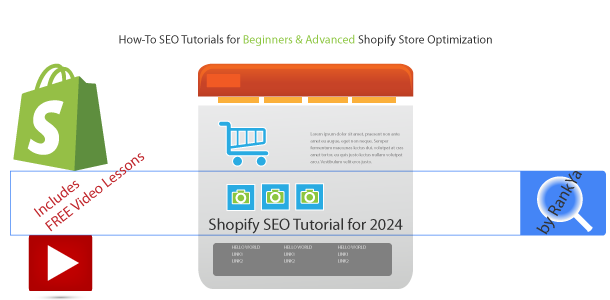If you’ve already implemented SEO on Shopify Product pages, great. If your eCommerce store is already getting some results, great. If you’re using SEO Apps thinking that will help, bad.
Now you can get THE BEST of THE BEST results your Shopify Store deserves by just simply changing few things and following RankYa SEO.
In the ever growing world of e-commerce, getting your Shopify store noticed by search engines like Google is crucial for driving organic traffic, and as a result, boosting Shopify e-commerce sales. Search Engine Optimization (SEO) is the key to achieving this.
Let’s first get the brutally honest truth about SEO in 2024 and how Google ranking algorithms are evolving.
Everything Google rankings has changed and will continue to change in 2024, right now, Google already rewards websites that create helpful, reliable, people-first content.
And yet, your Shopify store Google rankings need not fear because RankYa is here. I’ve created great how to tutorials for Shopify Store owners wanting great results in 2024.
Table of Contents
- Shopify SEO Tutorial for Beginners 2024 Video Lesson
- Advanced Shopify SEO Techniques 2024 Video Lesson
- Optimizing Your Shopify Store for Search Engines: A Step-by-Step Guide for beginners
- Advanced Shopify SEO Techniques
- Google Ranking Requirements & Search Engine Optimization in 2024
- SEO PDF for Shopify Store Optimization
Shopify SEO Tutorial for Beginners 2024 Video Lesson
Advanced Shopify SEO Techniques 2024 Video Lesson
Optimizing Your Shopify Store for Search Engines: A Step-by-Step Guide
In this “How to Optimize a Shopify eCommerce Website” latest Shopify SEO Tutorial for 2024 guide by RankYa, I will walk you through the essential steps to optimize your Shopify store for better search engine visibility, and also, show you advanced optimization techniques for #1 position Google rankings and higher website conversion rates.
Keyword Research
When looking for the right keywords, keep your hard earned money in your pocket and do not pay for BS keyword spy or keyword analysis softwares, because the only keyword research tool you’ll ever need is Google and its search engine itself.
If you haven’t already, begin by identifying relevant keywords for your Shopify products or services. Tools like Google Keyword Planner which will help you chooose the right keywords, Google Search box to see related searches “People also asked feature of Google” is a gold mine to identify and discover low-competition and high-traffic keywords. RankYa also has created great insights for how to do keyword research (includes VIDEO Tutorial). 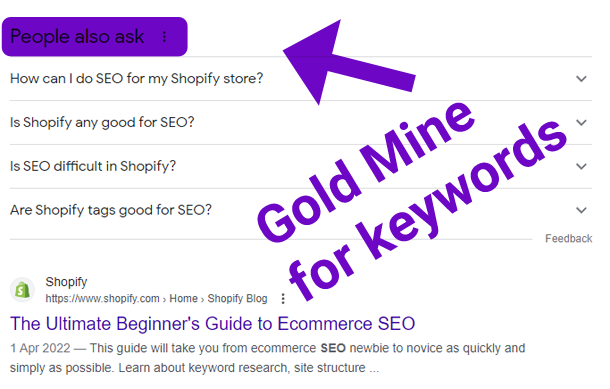
How Can I Do SEO for My Shopify Store?
Take a look at this image which highlights On-Page search engine optimization any e-commerce operator can easily incorporate. SEO PDF for Shopify Store 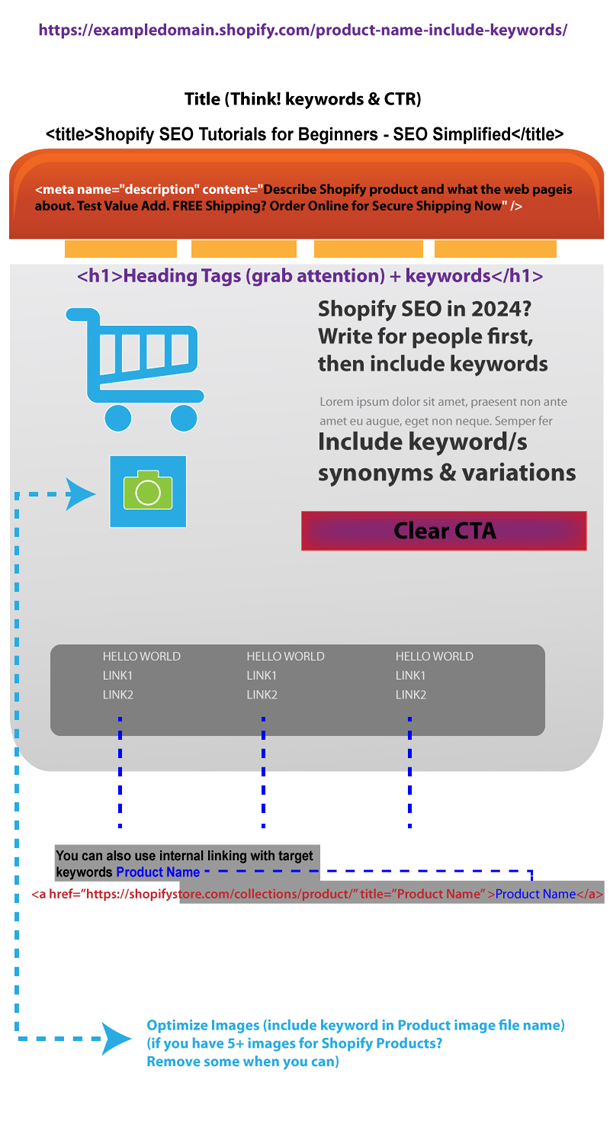
Optimize Product Titles and Descriptions
Incorporate your chosen keywords in a natural manner into product titles and meta descriptions. Be descriptive, highlight benefits, and ensure clarity. When crafted correctly, Google algorithms may show your web page Title and Meta Description in Google Search Results Page allowing you to enjoy higher Click Through Rate.
Create High-Quality Content
In 2024 Google rankings will be all about new type of content (not your average blog post). Typical Shopify Product URLs are limited in terms of amount of content, and type of content that can be placed on Product URLs. Mainly because Shopify Product URLs are focused towards “Add to Cart” or “Buy Now” instead of highlighting all the features and benefits of the product itself.
How do you solve this problem?
With a blog section on your Shopify store, which can be a powerful SEO tool in a sense that it will increase content amount under a given domain. Write informative, engaging, and relevant articles that provide value to your audience. 2024 SEO world will also require different type of content. For example: original images (not just stock images from product manufacturer website), any complimentary content (videos, pdfs, guides, product user manuals just to name a few).
Optimize Shopify Product Images
There is much you can do with web images. You can include important keywords in the product image file name. Compress images to improve page loading speed and use descriptive alt tags that include keywords related to the product.
Furthermore: in 2024 you should consider reducing the amount of Shopify Product images displayed in product image gallery. For example: instead of having 5+ images, can you accomplish the conversion with 3 images? These are the little factors that must be considered in the year 2024.
Utilize Clean URLs
Use clean, readable URLs that include relevant keywords. Avoid using long strings of numbers or random characters.
SEO Tip: if your website is using Google Search Console? Consider using noindex meta tags for Product variants. You can use regular expressions within Shopify Liquid. {% if collection.url contains 'test' and page.url == "/product?SomeQueryStringOrProductVariant" %}
// Do something here if conditions are not met. For example: noindex
<meta name="robots" content equals "noindex">
{% endif %}
Natural Backlinks Google Follows
RankYa has been informing followers NOT TO attempt backlinking campaings because it is against Google guidelines on links. You have to earn backlinks naturally from reputable sources to boost your site’s authority. This can be achieved through genuine collaborations with other website owners and also creating shareable content, and then entice website visitors to share the content (social share buttons etc.).
Outbound Links to Complimentary Sources
Did you know that links that point out to external websites also influence Google rankings? Whenever you can outlink because the resource on the other end will add value, then do so outlink. NOTE: do not make an honest mistake to just outlink to Wikipedia.
Improve Site Speed & Improve User Experience
Any slow-loading website can negatively impact user experience and SEO rankings. Use tools like Google PageSpeed Insights to identify and fix web page load speed issues. Furthermore: reduce web page clutter such as intrusive PopUps or notifications. In 2024, user experience will be a critical determining factor for higher Google rankings.
Mobile Optimization
Ensure your Shopify store is mobile-friendly and works well across all mobile devices (smartphone, Tablets, iPad, laptop and Desktop). With the increasing number of mobile device users, this is crucial for search engine optimization. 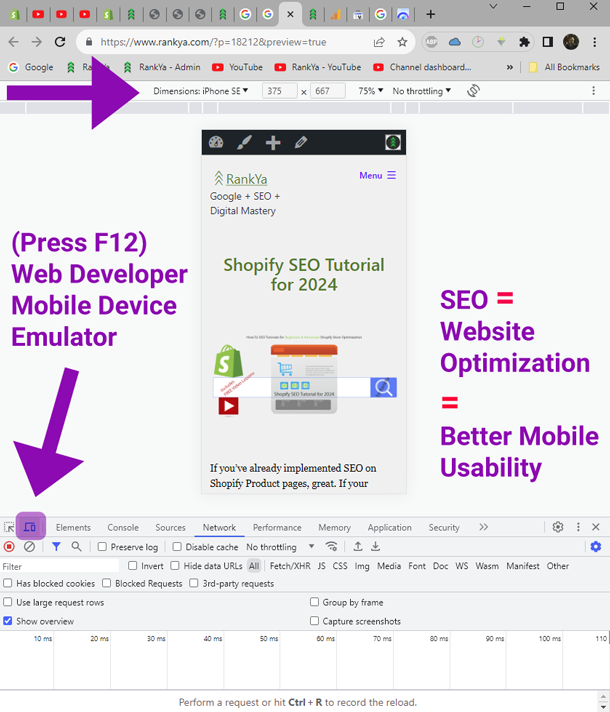
Leverage Social Media
Maintain an active presence on social media platforms such as Facebook Business Page or even YouTube if you are creating videos. Engaging with your audience on social media and sharing your content can lead to increased visibility as well as potential natural backlinks.
Monitor Analytics (Google Analytics and or Google Search Console)
Regularly analyze your website’s performance using tools like Google Analytics or Google Search Console Performance Reports. Track metrics like traffic, bounce rate, and conversion rate to make informed decisions. 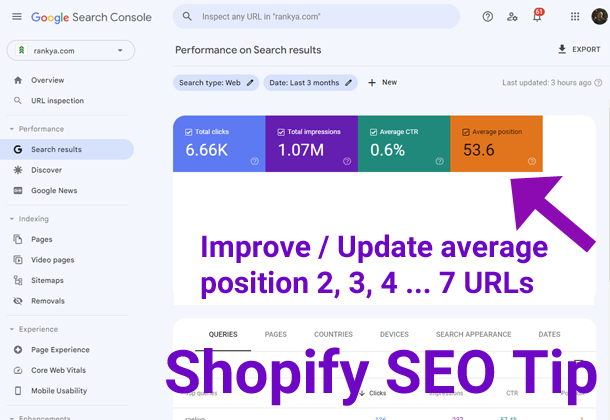
Advanced Shopify SEO Techniques
No Shopify Store can be said fully search engine optimized without optimizing the Shopify Theme. 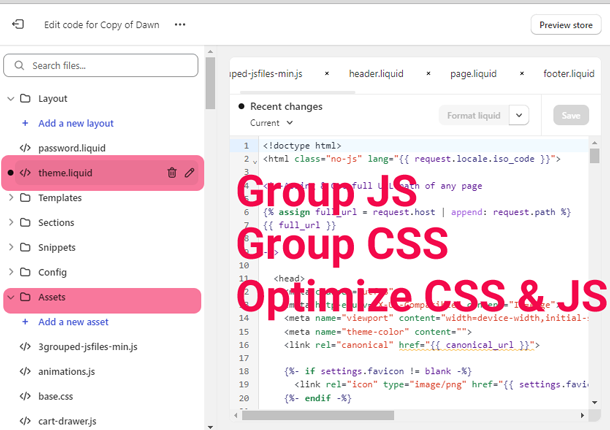 Shopify Content Management System uses a unique template language called Liquid. Shopify Liquid is a template language created specifically by Shopify for Shopify stores. Build on PHP and Object Oriented Programming means that web developers can optimize the Theme and its code. If you’re a web developer checkout Developer Cheat Sheet.
Shopify Content Management System uses a unique template language called Liquid. Shopify Liquid is a template language created specifically by Shopify for Shopify stores. Build on PHP and Object Oriented Programming means that web developers can optimize the Theme and its code. If you’re a web developer checkout Developer Cheat Sheet.
Although certain aspects of Liquid can be complex to optimize for most Shopify store owners, at minimum follow these steps below:
- Only use absolutely must use Apps (they are the main burden on Shopify CMS mainly due to poor coding practices by some Shopify App developers)
- Choose lightweight Shopify Theme
- Group JavaScript (JS) files to reduce HTTP Requests
- Group Cascading Style Sheets (CSS) files to reduce HTTP Requests
- Optimize CSS
Google Ranking Requirements & Search Engine Optimization in 2024
Optimizing your Shopify store for search engines should be thought as having 3 step process because of the latest SEO requirements in 2024.
- Implementing RankYa’s easy to follow search engine optimization steps and provide better web page user experience. Your shopify store is now setup perfectly.
- Create content for people.
- Continued content publishing and online marketing. Build authority in your field just as your target audience wants. Google wants the same in 2024.
Remember, SEO is a dynamic and ever changing field, and staying updated with the latest trends and Google algorithm changes is essential for increased conversions and sales as well as long-term results. Keep testing and refining your strategies to ensure your Shopify store continues to rank well in search engine results and performance.
